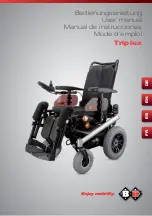
8.2 Cleaning
Cleaning of Frame
• The frame should be kept dry and free of debris and dirt.
• Clean the frame with a moist cloth.
• To maintain easy folding and adjustment, wipe the frame with a non-toxic, hypo allergenic and biodegradable lubricant
to moving parts as needed.
• Avoid using the wheelchair in salt-water environments that may cause corrosion on the frame. If the wheelchair is
exposed to the saltwater, it should be washed clean with water and wiped dry with a towel immediately. Apply lubricant
to all moving parts after the frame is dry.
Cleaning of Wheels and Wheel Locks:
• Wipe off dirt or mud from the wheels and brakes with a moist cloth as needed. The wheels and brakes should be clean
at all time as to not interfere with pushing and locking of the wheelchair.
• Readjust the brakes if necessary.
8.3 Storage
• To prevent rust or corrode, the wheelchair should be stored in a clean and dry area.
• Before extended storage periods, and before reuse, inspect the entire wheelchair according to the Maintenance/
Inspection Checklist.
• Apply lubricant to all moving parts.
• Before use, disinfect the entire wheelchair, especially the areas that come in contact with the user or caregiver, with
disinfectant wipes.
9. TRANSIT USE
The Miko has been crash tested according to the ISO 7176-19:2008 Wheelchair for use as seats in motor vehicles.
• Whenever feasible, the individual should transfer out of the wheelchair to a vehicle seat and use a vehicle occupant
restraint or should use a crash-tested child safety restraint system. The wheelchair should be safely stowed and
secured so as not to become a projectile in a crash or sudden driving maneuver.
• There should be sufficient free space around the wheelchair to avoid.
• It is important to engage wheel locks during transport.
• Four wheelchair tiedown straps should be used for effective wheelchair securement.
• BOTH pelvic and upper torso occupant restraints should be used to reduce the possibility of head and chest impacts.
• A headrest should be provided for use when traveling in a vehicle where other seated passengers have headrests.
• Do not place/hang any additional items onto the wheelchair during transport such as shopping bags or backpacks.
• Belt restraints should be positioned on wheelchair occupants in accordance with WTORS (Wheelchair Tiedown and
Occupant Restraint Systems) and/or the wheelchair manufacturer’s instructions.
• Sufficient forward and rearward clear space should be provided around the wheelchair occupant. The forward clear-
space zone (FCZ) needs to be larger when a shoulder-belt restraint is not used.
WARNING:
• The wheelchair has been dynamically tested in a forward-facing mode when loaded with a crash-test dummy
restrained with pelvic and shoulder belts. Both pelvic and upper torso belts designed for use as crashworthy
restraints in motor vehicles should be used to reduce the risk of serious injuries to wheelchair occupants.
• Alterations or substitutions should not be made to the wheelchair or seating system structural members, or to its
parts and components, without consulting the wheelchair manufacturer.
• This wheelchair should only be used in motor vehicles as described in these instructions





































